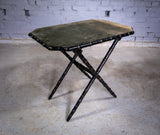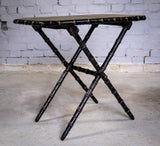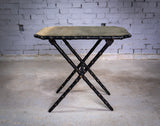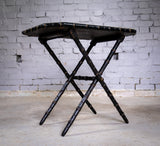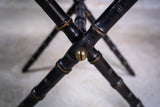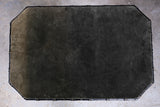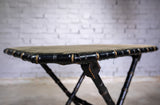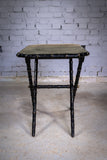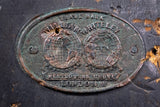A 19th century ebonised & gilt faux bamboo folding table by William Whiteley, London, c.1880.
The original Whiteleys department store was created by William Whiteley, who started a drapery shop at 31 Westbourne Grove in 1863. By 1867 it had expanded to a row of shops containing 17 separate departments. Claiming that he could provide anything from a pin to an elephant, William Whiteley dubbed himself "The Universal Provider".
Dressmaking was started in 1868, and a house agency and refreshment room, the first ventures outside drapery, opened in 1872. By then 622 people were employed on the premises and a further 1,000 outside. Whiteley's started selling food in 1875, and a building and decorating department was added in 1876. This proved to be particularly profitable, as the large stuccoed houses in the area needed regular repainting.
Whiteley's met strong opposition from smaller tradesmen, and also from the local authorities over its grand building plans, and several bad fires in the 1880s may have been caused by opponents. Business nonetheless prospered, aided by a delivery service extending up to 25 miles (40 km), and in 1887 the store was described as 'an immense symposium of the arts and industries of the nation and of the world'. The first store – described as "an immense symposium of the arts and industries of the nation and of the world" – was devastated in an enormous fire in 1887, one of the largest fires in London's history. This was the last of four fires that had devastated the business from 1882. In 1887 disaster struck and the store in Westbourne Grove burnt down.
On 24 January 1907, Whiteley was shot dead at his shop by Horace George Rayner, aged 29, who claimed that he was Whiteley's illegitimate son. In his will Whiteley left £1 million (a fabulous amount at that time, equivalent in 2018 to £103 million). Some of the money was used to create Whiteley Village, a retirement village near Walton-On-Thames.
Following his death, Whiteley's two sons carried on operating the business and opened a new shop in 1912. This was eventually sold to Harry Gordon Selfridge in 1927.
This William Whiteley piece is a rare survivor and has retained its original material to the top; as such there is some historic fading to one side where it has likely been placed next to a window. There are some small areas of damage to the wood to the underside of the table, but this does not affect the stability of the table in any way. The folding mechanism still functions perfectly and the William Whiteley plaque remains clearly visible to the underside.
A scarce and attractive piece.
Dimensions (in upright position)
Length: 71cm
Width: 47.5cm
Height: 61cm












